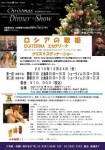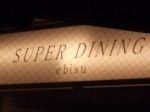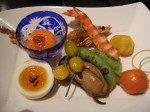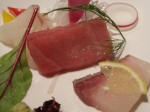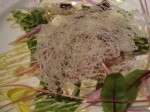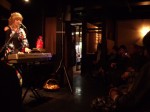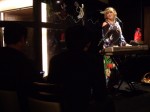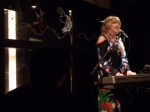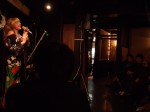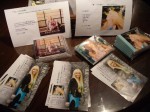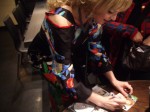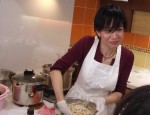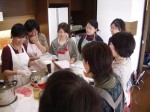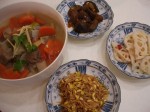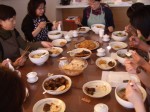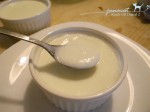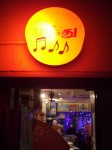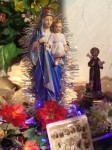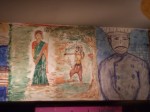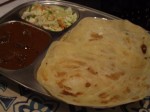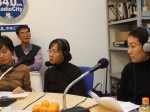
We spent a wonderful Christmas night with wonderful guests. Sohon Se, a cooking instructor from Taiwan, Naoko Tanase, a representative of a cooking school called “Niki’s Kitchen” and Sohon’s relatives from America. We talked about Happy Holidays in the world.
今週は、2010年最後のMy Eyes Tokyo!というわけで、たくさんの人たちと一緒に、スタジオで聖なる夜を過ごしました。先週もお越しいただいた、Niki’s Kitchenで台湾中華料理を教えているソホンさん、この番組には2回目のご出演、Niki’s Kitchen主宰の棚瀬尚子さん、そして何と、台湾への経由地として日本に来た、現在はアメリカ在住のソホンさんのご親戚の方々、総勢5名の方々がスタジオに遊びに来てくれました。日・米・台・露の4カ国・地域の首脳(?)が一堂に会し、世界のクリスマス&新年のお料理や過ごし方を語り合いました。
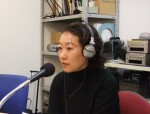
Tanase told us about a South American Christmas dish called “tamale”. Sausages, meats, eggs and vegetables are steamed in a leaf wrapper – that’s a tamale.
In Latin America, people make big donuts called “rosca de reyes” and they implant a pottery doll in each donut on January 6. They eat it one by one and a person who bites a doll has to prepare tamales for people on February 2.
まずは、いろんな国のクリスマス食料事情について。棚瀬さんが南米のユニークなクリスマスメニュー”タマレス”について教えてくれました。バナナやトウモロコシの葉の中に、ソーセージやお肉、卵、野菜などを包み込んで蒸し上げるお料理だそうです。
このタマレスですが、お正月にも関係してくるようです。年明けの1月6日に大きなドーナツのようなもの(ロスカ・デ・レジェ)を作り、中に一つだけ瀬戸ものを入れて、端から順番に一人ずつ食べて行きます。そしてその瀬戸ものに「カチン!」と当たった人が、2月2日にみんなにタマレスを振る舞うという風習があるんだとか。
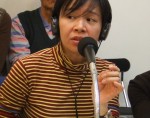
In Taiwan, they have almost no particular Christmas dinner, but restaurants serve many kinds of Christmas menus. Then people enjoy Chinese New Year (in 2011, February 3) much more than Gregorian New Year. Originally January 1 is the National Foundation Day of Republic of China and they consider January 1 is a continuation of Christmas.
A typical New Year dish in Taiwan is fish. Taiwanese people think there is luck in fish. They bake it until it becomes firm on New Year’s Eve (*in 2011, February 2) and they eat on New Year’s day (February 3).
They have toshi koshi soba (year-end noodles), too. But their noodles are a little bit different from Japanese one. They eat chow mein (pan-fried noodles). I didn’t know that at all.
台湾は日本と同じように、特にクリスマスディナーというものは無いようですが、街のレストランではクリスマスメニューがたくさん用意されているそうです。そして台湾の新年は、グレゴリオ暦のお正月(1月1日)よりは圧倒的に旧正月(2011年は2月3日)に大いに盛り上がるのだそうです。1月1日は元々中華民国の建国記念日で、台湾人の感覚では”クリスマスの延長”のようです。
台湾のおせち料理は、魚。なぜなら魚は中国語で「餘(余)」と発音が同じで、”お金や食べ物がたくさんある”ことを示す縁起の良いお料理だからです。大晦日(来年は2月2日に相当)に魚を硬〜く焼き、その日は食べずに元日(来年の2月3日)までとっておき、元日にそれをお母さん方が別の料理に変身させるのだそうです。
ちなみに、台湾にも年越しそばが存在するそうです。でも、おそばはおそばでも「焼きそば」とのこと。面白いですね!
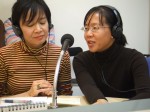
As for Sohon’s relatives. They’ve been living in the US for a long time and Carol (At right in photo above) is an American-born woman. So they eat typical American Christmas dinner, such as bread- or vegetable-stuffed turkeys, hams, mashed potatoes and pies. But on the other hand, they’re immigrants from Taiwan so they have both American dishes and Chinese dishes on Christmas night.
そして、ソホンさんのご親戚。長年アメリカのテキサス州にお住まいで、中でもキャロルさん(写真右)はアメリカ生まれアメリカ育ち。なので皆さんご存知のアメリカンスタイルのクリスマスディナーをいただくそうです。七面鳥の丸焼き(パンや野菜などの”スタッフィング”を詰め込んだもの)またはハム、マッシュポテト、そしてデザートにはパイという感じです。でも、台湾からの移民ということもあり、食卓にはそれらのような”This is America!”のようなディナーと一緒に、中国の麺料理も並ぶそうです。

In Russia, they often make vegetable- or rice-stuffed chickens. Where she comes from, Siberia, people don’t often eat turkeys. She guesses that turkeys don’t like the cold.
On New Year’s Day, they eat dumplings like Chinese jiao-zi. Are those pelmeni?
ロシアはクリスマスシーズンに限らず、チキンの中に野菜やお米などを詰めたお料理を作るそうです。エカテリーナさんの故郷のシベリアでは、人は七面鳥をあまり食べないそうです。七面鳥は寒いのが苦手だから・・・?とエカテリーナさんは推測しています。
そしてロシアのおせち料理ですが、エカテリーナさんの生まれたシベリアは中国に近いため、意外にも餃子、それも水餃子をたくさん作るのだそうです。形は中国や日本のものとは違い、ドーナツのように円い輪っかなんだとか。ひょっとして、これが「ペリメニ」なのかな?大変短い時間でしたが、と〜〜〜っても勉強になりました!

Christmas Day will be gone soon. Best wishes for a happy new year and see you again at 7PM on January 8, 2011!
クリスマスはもうすぐ終わりを迎えますが、どうか皆さん、良いお年をお迎え下さい。そして来年もどうか私とエカテリーナさんのコンビによるこの番組を、宜しくお願いいたします!
*今週の放送の最後に「新年の第1回目は1月7日です!」と勢い良く言ってしまいましたが、実際は1月8日(土)の夜7時〜放送です。大変申し訳ございませんでした。毎週土曜日の夜7時〜7時半という時間帯には来年も変更はございませんので、安心してお聴きいただけたらと思います。
